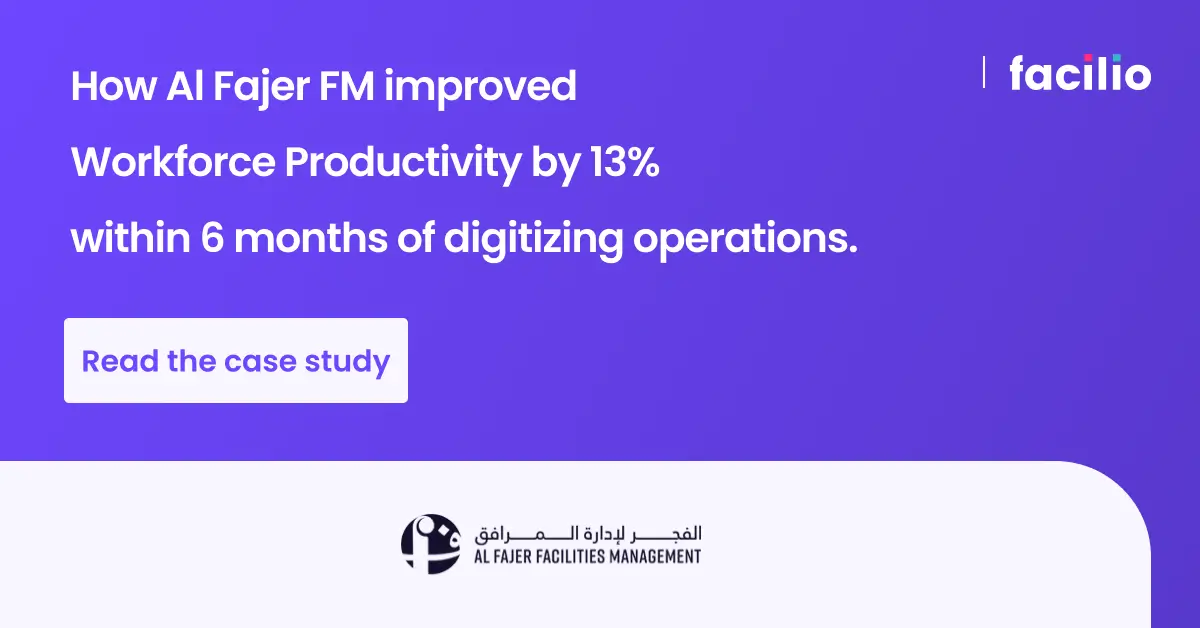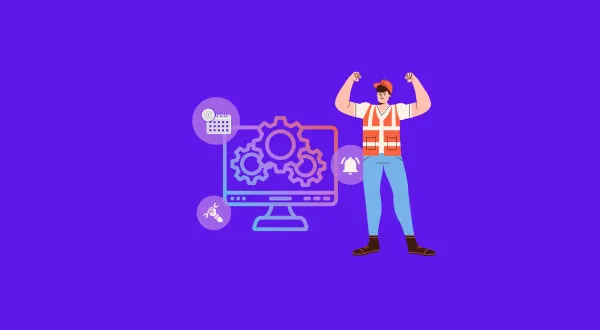Discover how a mobile workforce management software can optimize your mobile workforce. Learn how it is bound to enhance productivity, ensure compliance, and streamline operations for efficiency.
Managing a dispersed workforce has become a crucial challenge for facility management teams. With technicians, engineers, and support staff constantly on the move across sites, ensuring seamless communication and task execution is paramount.
A well-structured IFM field workforce management strategy is critical for maintaining service quality and operational efficiency.
What is mobile workforce management?
The benefit of a mobile workforce management approach is that it reduces downtime, boosts personnel accountability, and can improve overall customer satisfaction. Further, it helps the entire facilities maintenance team work as a unified and agile unit.
Key advantages of mobile workforce management
Mobile workforce management can help a facility manager run smooth operations and improve KPIs that they are accountable for.
Here is a gist of some of its key advantages.
Maximized team productivity
Mobile workforce management solutions significantly enhance a facility manager's productivity by providing a suite of cloud-based tools, including web and mobile applications, that streamline facility operations.
These tools deliver real-time visibility into work order status, enabling proactive decision-making. Additionally, they automate and optimize technician dispatching based on factors like skills, location, and workload, ensuring efficient resource allocation.
Furthermore, technicians receive instant access to critical job details, asset histories, and checklists through their mobile devices, promoting first-time fix rates and minimizing downtime.
Better operational flexibility
Mobile workforce management solutions empower your maintenance team to navigate the unpredictable world of facility operations with unprecedented agility.
Urgent requests? Shifting priorities? Resource constraints? No problem.
Reassign tasks, re-prioritize on the fly, and optimize resource allocation in real-time – all from the palm of your hand. This level of responsiveness translates directly into exceptional service levels, delighting occupants and boosting customer satisfaction.
Research consistently shows that swift, efficient service resolution is a key driver of positive customer experiences.
Better decision-making
Mobile workforce management software equips facility managers with the power of real-time data and insights, delivered through intuitive visual dashboards.
This data-driven visibility empowers proactive decision-making, transforming operations from reactive to strategic.
The reporting dashboard, combined with advanced analytics, offers a bird's-eye view of your entire facility ecosystem. Identify bottlenecks before they impact service levels, anticipate resource needs with precision, and take preemptive corrective actions to ensure optimal performance.
Optimizing costs, maximizing value
Mobile workforce management solutions are not only a catalyst for operational efficiency but also a powerful tool for cost optimization. By streamlining workflows, automating tasks, and optimizing resource allocation, facility managers can achieve significant cost savings in both operational expenditures (OPEX) and capital expenditures (CAPEX).
Reduced overtime, minimized travel times, and improved first-time fix rates contribute to lower OPEX. Meanwhile, the ability to proactively identify maintenance needs and extend asset life cycles translates into substantial CAPEX savings.
Mobile workforce management solutions offer a compelling return on investment, transforming cost centers into strategic assets.
Sustainability
Mobile workforce management solutions don't just streamline operations; they empower your team to embrace sustainability as a daily habit. By providing real-time data on energy usage, waste generation, and asset performance, these tools foster a culture of awareness and accountability. Technicians become active participants in conservation efforts, empowered to identify and address inefficiencies in their daily tasks.
Optimized routes and schedules minimize environmental impact, while digital workflows reduce paper waste and promote eco-conscious practices.
With mobile workforce management, sustainability becomes more than a corporate initiative—it's a shared responsibility embedded in the daily workflow of your team.
Improved communication
Real-time messaging, task updates, and centralized information hubs dismantle communication silos, enabling seamless information sharing across teams and departments.
Technicians in the field stay connected with managers and colleagues, ensuring swift response to urgent requests and minimizing downtime.
This enhanced communication fosters a culture of collaboration, where teams proactively share knowledge, troubleshoot issues, and contribute to continuous improvement.
Several facilities across the globe have benefited from using mobile workforce management software. Al Fajer, a facilities management company with workforce and operations across the GCC region is a good example.

Mobile workforce management (MWM) and field service management (FSM): key differences
While Mobile Workforce Management (MWM) and Field Service Management (FSM) both deal with managing a workforce that operates outside of a traditional office setting, they have key distinctions in focus and functionality:
In essence:
- MWM is a comprehensive solution to manage any type of mobile workforce. It's about optimizing overall workforce efficiency and communication.
- FSM is more specialized, tailored to the specific needs of field service operations, with a strong focus on customer satisfaction and service level agreements (SLAs).
While there can be some overlap in functionality, understanding these core differences is crucial when choosing the right solution for your organization's specific needs.
Despite all the benefits, why is mobile workforce management challenging? What restricts facilities managers from leveraging it to the fullest?
Challenges with mobile workforce management
There are specific challenges, mostly technology-based, that restricts facilities managers from maximizing their mobile workforce productivity.
- Mobile-first management: Shifting from traditional workforce management practices to a mobile-first approach is challenging due to inconsistent tech adoption, resistance to change, and varying digital literacy among technicians.
- Complexity of a blended workforce: Managing a blended workforce consisting of on-site employees, remote workers, and third-party vendors is yet another challenge.
- Connectivity Issues: Poor or inadequate network coverage in remote areas hinders real-time data exchange, communication, and location tracking.
- High customer expectations: Growing customer demand for faster service and real-time updates adds extra pressure on the workforce, especially when relying on outdated or manual systems
- Data-based decision-making: Making sense of large amounts of data can be tough, especially when interoperability of disparate systems limits data exchange.
- Integration Challenges: Integrating mobile workforce management with traditional systems or third-party software can be tricky and expensive, often leading to inefficiencies and data silos.
- Security concerns: As more data is accessed across various devices, there’s a greater risk of security breaches and vulnerabilities.
- Statutory and regulatory compliance: Ensuring compliance with industry regulations, safety standards, and sustainability regulations is an ongoing challenge in mobile workforce management.
Trends in mobile workforce management shaping the future of facilities management
While this article is being written, there are new trends emerging in facilities management. They are changing mobile workforce management for the better and can make everyday operations easier to manage for facility managers.
The rise of mobile-first platforms
By 2024, over 90% of workers in the US will be using mobile devices for work tasks (Statista). Mobile-first platforms offer agility, keeping employees connected and productive from any location. Teams and stakeholders can access service requests, schedules, and updates in real-time via smartphones or tablets.
Cloud-based solutions
Cloud systems store data from mobile applications and ensure smooth information exchange. They provide real-time updates, prevent duplicate work orders, and offer a unified view of service requests across the portfolio.
IoT integration
IoT devices with smart sensors provide real-time data on asset performance, employee locations, and environmental conditions. This helps forecast maintenance needs, reducing asset downtime and improving efficiency.
AI Integration
AI tools optimize field service scheduling and automate processes. Using data from IoT sensors, AI predicts equipment failures and suggests maintenance schedules to prevent breakdowns, streamlining operations.
We have seen the most pressing challenges in mobile workforce management and also the emerging trends that could give respite to the challenges.
The need of the hour is a reliable mobile workforce management software that can mitigate the challenges and unlock efficiencies.
Facilio: A mobile workforce management software to unlock high-performance
Traditionally, CMMS (Computerized Maintenance Management Systems) and CAFM (Computer-Aided Facility Management) systems have primarily focused on asset management and maintenance workflows. While they may offer some basic work order management capabilities, they often lack the robust features and flexibility required for comprehensive mobile workforce management.
This disconnect between core facility management systems and mobile workforce operations has historically created silos, leading to inefficiencies, communication gaps, and missed opportunities for optimization.
Facilio's solution addresses this challenge by integrating mobile workforce management capabilities directly into its CMMS software.
This unified platform approach empowers FMs to:
- Break Down Silos: Eliminate data fragmentation and improve cross-functional collaboration.
- Optimize Resource Allocation: Ensure the right technician with the right skills is assigned to the right task at the right time.
- Enhance Operational Efficiency: Streamline workflows, reduce manual processes, and minimize downtime.
- Improve Service Levels: Deliver faster, more efficient service, leading to higher customer satisfaction.
- Reduce Costs: Optimize labor utilization, minimize overtime, and improve asset lifecycles, resulting in significant cost savings.
- Make Informed Decisions: Leverage real-time data and analytics to gain insights, identify trends, and make data-driven decisions that improve overall performance.
Facilio as a mobile workforce management software empowers facility management teams to achieve high-performance by streamlining mobile workforce operations. It offers real-time task tracking, AI-driven insights, and integrations that work with almost every third-party software.
With Facilio you will be able to maximize mobile workforce productivity, SLA compliance, and operational efficiency.
Here is a quick overview of its key capabilities in mobile workforce management.
Showcase real-time progress
With Facilio, facility managers gain real-time visibility into their mobile workforce’s activities. By tracking task progress, location data, and resource utilization, managers can ensure operations remain on track and make timely adjustments when necessary.
This increased transparency helps teams stay coordinated and responsive throughout the workday. Further, real-time updates are a surefire way to win customer trust as well.
Ensure maximum SLA compliance
Meeting service-level agreements (SLAs) becomes easier with Facilio's automated prioritization and compliance tracking. The platform alerts teams to potential SLA breaches before they happen, allowing for proactive intervention.
This ensures that high service standards are maintained while preventing penalties and ensuring smooth operations.
Monitor key O&M metrics
From inventory to labor costs — Facilio maintains an accurate tack of key O&M metrics. The platform delivers actionable insights through easy-to-read dashboards, helping managers make informed decisions and continually optimize their facility management for better outcomes.
Integrations for seamless data exchange
Facilio has BIM, HVAC, and several other third-party software which makes data exchange seamless. Technicians and facility managers don’t have to hop from one application to another to comprehend and act on data.
With Facilio, you can take your mobile workforce’s efficiency to new heights. It removes bottlenecks, streamlines workflows, and automates routine processes for accuracy.

